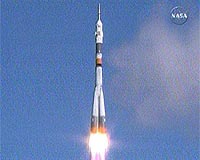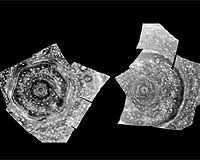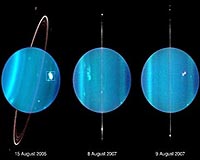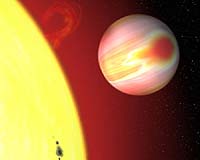| October 14, 2008 |  |
SpaceDaily Advertising Kit |
|
Expedition 18 Crew Launches From Baikonur Baikonur, Kazakhstan (SPX) Oct 14, 2008  Commander Edward Michael "Mike" Fincke and Flight Engineer Yury Valentinovich Lonchakov of the 18th International Space Station crew launched in their Soyuz TMA-13 from the Baikonur Cosmodrome in Kazakhstan at 3:01 a.m. EDT Sunday to begin a six-month stay in space. Less than 10 minutes after launch their spacecraft reached orbit, and its antennas and solar arrays were deployed shortly ... read more
Commander Edward Michael "Mike" Fincke and Flight Engineer Yury Valentinovich Lonchakov of the 18th International Space Station crew launched in their Soyuz TMA-13 from the Baikonur Cosmodrome in Kazakhstan at 3:01 a.m. EDT Sunday to begin a six-month stay in space. Less than 10 minutes after launch their spacecraft reached orbit, and its antennas and solar arrays were deployed shortly ... read moreDLR Institute Of Space Systems Up And Running  Bremen, Germany (SPX) Oct 14, 2008
Bremen, Germany (SPX) Oct 14, 2008With the inauguration of their new laboratory and office building on 13 October 2008, the 68 staff members of the Institute of Space Systems (Institut fur Raumfahrtsysteme) of the German Aerospace Center (Deutsches Zentrum fur Luft- und Raumfahrt; DLR) have now fully taken up their scientific duties at DLR's new Bremen site. This strengthens Bremen's position as a centre for space technology ... more |
US pushes to revoke scientific ruling that underpins climate regulations
US to overturn foundational climate ruling on Tuesday LA wildfires push insurance losses to highest since 2011: Munich Re Russian space chief to meet NASA head for first time in eight years Turkey's glaciers fall victim to climate change Spain helps Portugal fight mountain fire Philippine flooding centre stage at Marcos state of nation speech Blazing heat in Iraq as Baghdad, south top 50C UN climate chief challenges Australia to curb emissions New Zealand farmers battle pine forests to 'save our sheep'
|
|
| Previous Issues | Oct 13 | Oct 12 | Oct 10 | Oct 09 | Oct 08 |
China To Launch FY-4 Weather Satellite Around 2013 Beijing (XNA) Oct 14, 2008
Beijing (XNA) Oct 14, 2008China plans to launch the first satellite of the Fengyun-4 (FY-4) series by 2013, said the China Meteorological Administration (CMA). The FY-4 project involves the country's second-generation of geo-stationary meteorological satellites. Leading scientists and engineers believe FY-4 could help China more accurately forecast weather, climate, environment and natural disasters, when it is ... more Opportunity Takes A Victory Lap  Pasadena CA (SPX) Oct 14, 2008
Pasadena CA (SPX) Oct 14, 2008A journey of 7.5 miles began with a partial victory lap around "Victoria Crater," as Opportunity headed south toward enormous "Endeavour Crater." Partway around the circuit, Opportunity passed the 7.5-mile mark of the mission. In metric terms, the rover began a 12,000-meter, cross-country trek by ending a similar 12,000-meter journey across uncharted terrain and in and out of craters. ... more NASA's Spitzer Gets Sneak Peak Inside Comet Holmes  Pasadena CA (SPX) Oct 14, 2008
Pasadena CA (SPX) Oct 14, 2008When comet Holmes unexpectedly erupted in 2007, professional and amateur astronomers around the world turned their telescopes toward the spectacular event. Their quest was to find out why the comet had suddenly exploded. Observations taken of the comet after the explosion by NASA's Spitzer Space Telescope deepen the mystery, showing oddly behaving streamers in the shell of dust surrounding ... more |
saturn:
 extrasolar:  uranus:  |
The Sun Is Setting On Phoenix Moffett Field CA (SPX) Oct 14, 2008
Moffett Field CA (SPX) Oct 14, 2008As fall approaches Mars' northern plains, NASA's Phoenix Lander continues to dig into the red planet's soil and deliver samples to its onboard science instruments for analysis. Over the past two weeks, Phoenix's nearly 2.4-meter-long (8 foot) arm moved a rock named "Headless" about 0.4 meters (16 inches) and snapped an image of the rock with its camera. Then the robotic arm scraped the ... more Jet Streams On Giant Planets  Tuscon AZ (SPX) Oct 14, 2008
Tuscon AZ (SPX) Oct 14, 2008Turbulence generated by thunderstorms can drive the multiple east-west jet streams on the giant planets -- Jupiter, Saturn, Uranus, and Neptune -- and explain a long-standing conundrum concerning the puzzling differences between the innermost two planets, Jupiter and Saturn, and the outermost two, Uranus and Neptune. Scientists have been trying to understand the mechanisms that form the ... more Free US wireless network a step closer  Washington (AFP) Oct 13, 2008
Washington (AFP) Oct 13, 2008A free nationwide wireless Internet network has moved one step closer to becoming a reality in the United States following a key finding by the US Federal Communications Commission (FCC). Major US telecommunications companies have opposed opening up unused portions of the US airwaves to wireless Web use, but a new report by FCC engineers has essentially shot down one of their major arguments ... more Faint Gamma-Ray Bursts Do Actually Exist  Paris, France (ESA) Oct 14, 2008
Paris, France (ESA) Oct 14, 2008Gamma-ray bursts, powerful glares of high-energy that wash through the Universe once every day or so are, for a brief time, the brightest objects in the gamma-ray sky. ESA's Integral gamma-ray observatory has observed several low-luminosity gamma-ray bursts, confirming the existence of an entire population of weaker bursts hardly noticed so far. When it comes to detecting gamma-ray bursts ... more |
extrasolar:
 abm:  milspace-comms:  |
| Previous Issues | Oct 13 | Oct 12 | Oct 10 | Oct 09 | Oct 08 |
| The contents herein, unless otherwise known to be public domain, are Copyright 1995-2008 - SpaceDaily. AFP and UPI Wire Stories are copyright Agence France-Presse and United Press International. ESA Portal Reports are copyright European Space Agency. All NASA sourced material is public domain. Additional copyrights may apply in whole or part to other bona fide parties. Advertising does not imply endorsement, agreement or approval of any opinions, statements or information provided by SpaceDaily on any web page published or hosted by SpaceDaily. Privacy statement |